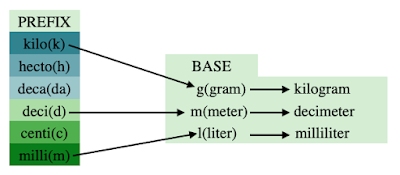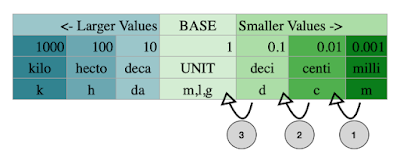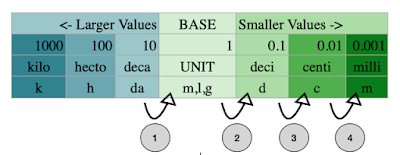The United States and the Metric System
Who uses the Metric System?
The entire world uses the metric system or The International System of Units (SI) for measurements except for Liberia, Myanmar, and the United States of America.In the USA they use Customary Units like inches, feet, pounds, quarts, and gallons. This is fine except that you have to memorize or look up the strange conversions to get from one unit to another.
What is the Metric System?
To avoid confusion and strange conversions, scientists around the world have adopted the metric system, which is based on multiples of 10.
There are seven base units in the Metric System: the meter (m), the kilogram (kg), the second (s), the kelvin (K), the ampere (A), the mole (mol), and the candela (cd). In order to measure anything smaller or larger than these base units, you can add a prefix that the multiple of 10. There are six prefixes that go smaller and larger than the base unit.
Though there are 7 base units, meter, liter, and gram are the ones that you're most likely to come in contact with within day-to-day work. In the middle are the base units with a value of one (01), like 1m, 1l, or 1g, and on the right will be smaller values and to the left will be larger values.
If we want to use a unit that's ten times smaller than the base value because a meter, liter, or gram are too big, we can go down to the 1/10 and use the prefix "deci" which is abbreviated with the letter "d". Then you can have a decimeter deciliter or decigram.
1/100 is "centi" with the letter "c" for centimeter, centiliter, and centigram.
1/1000 is "milli" with the letter "m" from millimeter, milliliter, and milligram.
We can go to larger units when we're measuring larger things too. 10 times larger than the base unit is "deca" and is abbreviated with "da" to distinguish it from "deci". So you can have decameters, decaliters, and decagrams.
100 times larger than one unit is "hecto", with the letter "h" for hectometer, hectoliter, and hectogram and 1000 times larger than the base unit is "kilo" or "k" for kilometer, kiloliter, and kilogram.
1/100 is "centi" with the letter "c" for centimeter, centiliter, and centigram.
1/1000 is "milli" with the letter "m" from millimeter, milliliter, and milligram.
We can go to larger units when we're measuring larger things too. 10 times larger than the base unit is "deca" and is abbreviated with "da" to distinguish it from "deci". So you can have decameters, decaliters, and decagrams.
100 times larger than one unit is "hecto", with the letter "h" for hectometer, hectoliter, and hectogram and 1000 times larger than the base unit is "kilo" or "k" for kilometer, kiloliter, and kilogram.
Is the Metric System hard to learn and use?
We can use a mnemonic to remember the order from "kilo" to "milli".
"king henry died unexpectedly drinking chocolate milk"
But you can make up your own to help you remember their order.
Let's see how to use this information,
You can take any prefix and attach it to any metric base unit.
If you choose "kilo" and "gram" you'd have a "kilogram" with the symbol "kg" or you could choose "deci" and "meter" and get a "decimeter" with the symbol "dm" or you could choose "milli" and "liter" and get "milliliter" with the symbol "ml". Similarly, you could make any combination.
There's one other really great thing about the metric system and that's how easy it is to convert from one type of measurement to another.
When you write the units out in order of largest to smallest, the conversions can be very easy to remember since the smaller values are on the right and the larger values are on the left.
Let's say you had 100 milligrams and you wanted to convert it into grams. 100 mg = .... g ?
First, you look at the prefix, which is "milli". So, we're going to start from "milli" and move to the left until we get to grams.
We need to move three times until we get to grams. This means we need to move the decimal point three places to the left. Which gives us, 100 mg = 0.1 g
Let's try another question,
2.5 dal = .... ml ?
Let's start with "deca" and move it to the right until we get to "milli".
We need to move four times until we get to "milli". So, move the decimal four places to the right and you get twenty-five thousand milliliters. Therefore, 2.5 dal = 25,000 ml.
Let's try two more questions using the mnemonic to write out the first letters of the prefixes.
Let's convert 4.26 cm to kilometers. 4.26 cm = .... km?
Let's try two more questions using the mnemonic to write out the first letters of the prefixes.
Let's convert 4.26 cm to kilometers. 4.26 cm = .... km?
Start at "centi" and move five places to the left and move the decimal in the same direction the same number of times and you get the answer as 4.6 cm = 0.0000426 km.
It's always better to do a logic check and see if your answer makes sense, 4.2 cm is a very small measurement already. So, it makes sense though it would be an extremely small fraction of a kilometer.
Let's do one last conversion,
0.0024 hl = .... ml?
It's always better to do a logic check and see if your answer makes sense, 4.2 cm is a very small measurement already. So, it makes sense though it would be an extremely small fraction of a kilometer.
Let's do one last conversion,
0.0024 hl = .... ml?
Start at "hecto" and go five places to the right and move the decimal to the same number of spaces and you get 240 milliliters which is probably a better unit for the smaller volume, 0.0024 hl = 240 ml.







